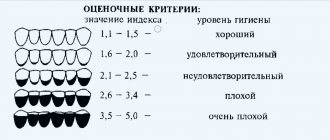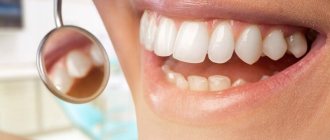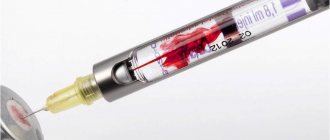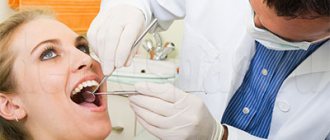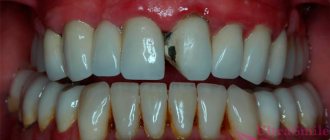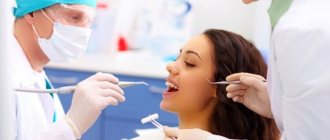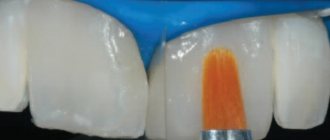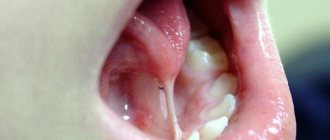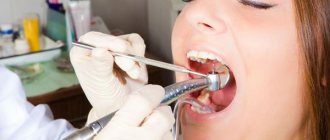When the gums become inflamed, swollen and bleed, even if the symptoms are very mild, we can talk about a disease such as gingivitis .
Unfortunately, there is nothing special about such a diagnosis, since healthy periodontal tissue is found in only three percent of our fellow citizens. We are accustomed to ignoring minor manifestations of this disease, but it can lead to damage to deeper tissues, after which the process becomes irreversible. When gingivitis develops into periodontitis, doctors can only stop the disease for a while, but one day there comes a time when a person loses teeth. Therefore, it is very important to regularly check your gums for inflammation, and if gingivitis is detected, actively engage in treatment.
Patients often underestimate the seriousness of the situation and try to recover on their own. This is not the best move, because in the fight against gingivitis, reliable diagnosis and a properly designed course of treatment are important. And in order to be able to effectively fight the disease, you need to have a certain understanding of it.
Negative or iodine-negative Schiller test
Often, only with the help of a test with Lugol's solution, it is possible to identify areas of pathologically altered epithelium, when upon examination they are visually practically indistinguishable from healthy ones in color and relief, since they do not rise above the surface of the surrounding tissues.
With a negative or iodine-negative Schiller test, the altered epithelium will be stained with Lugol's solution in different shades. The changed areas during the Schiller test have a lighter color, with clear edges - the so-called silent iodine-negative area (usually keratinized epithelium).
Pathologically changed cells are stained with Lugol's solution with different shades, depending on the type of damage and the degree of keratinization (keratinization) of the tissue. In this case, the iodine solution stains only the changed integument (epithelium) with varying intensities of canary yellow color.
Symptoms of gingivitis
Despite the fact that there are many causes and types of gingivitis, dentists most often encounter catarrhal, usually chronic, gingivitis. Its very first symptoms are slightly swollen gums with redness, as well as discomfort on the teeth from hot and cold water.
The next manifestation is bleeding gums during hygiene procedures; this is already an average form of the disease. It is very important to start treating it immediately when a symptom is detected. And finally, if your gums bleed at night, then you have a severe form of gingivitis. It requires urgent professional intervention.
Less common symptoms are:
- yellow or red sores,
- gum overgrowth
- atrophy, pain.
Schiller test value
Of great importance in the differential diagnosis of normal and atypical patterns is the color shade and the clarity of the zone boundaries.
The presence of clear boundaries indicates an unfavorable situation. Benign lesions usually have less sharp, blurred contours.
Thus, the test expands diagnostic capabilities and allows:
- preliminary assess the degree of damage, size, depth and number of pathologically changed areas;
- determine patient management tactics;
- evaluate the effectiveness of treatment measures,
- to clarify the features of changes in stratified squamous epithelium under various physiological conditions (pregnancy, menopause, contraception).
Causes
Gingivitis in most cases has several causes.
Firstly, rarely do any patients satisfactorily monitor oral hygiene, so first plaque and then tartar form on the teeth. Tartar hides a lot of pathogenic bacteria.
Secondly, many of us have gastrointestinal diseases, which also provoke gingivitis.
Thirdly, often in the oral cavity, or in general in the human body, immune defense is reduced. The reason for this is an unhealthy lifestyle, vitamin deficiency, bad habits, and chronic conditions such as stress.
More rare causes include burns of the mucous membrane, teething, heart disease, diabetes and others.
In addition, incorrectly installed veneers and braces, poorly made, old and decaying fillings can lead to increased gingivitis.
Process
The test is carried out using a solution consisting of iodine, potassium iodide and distilled water.
During the test, the doctor opens the woman's cervix using a speculum. Next, using a tampon, the cervix is cleared of any secretions and mucus present. Having finished this, Lugol's solution is administered.
This solution should be in such quantity that the cervix is completely immersed in it. In a number of situations, the area under study is lubricated with a swab, which is pre-wetted in a composition consisting of glycerin and Lugol's solution. Next, the solution is removed, and the treated area is dried using a cotton swab. The technique of the procedure ends with another examination of the condition of the cervix.
The result will be in just 5 minutes, the procedure itself is painless, so no anesthesia is used. But having the solution in the vagina can cause some discomfort.
There is no point in conducting a test at every visit to the gynecologist. It is enough to perform the Schiller test once a year. If a woman is diagnosed with some kind of disease, then it is considered necessary to carry out the procedure 2-3 times a year until the test is negative.
Result: index calculation, assessment of gum condition
For objectification purposes, the Schiller-Pisarev test is expressed in numbers (scores). The color of the papillae is rated at 2 points, the gingival margins at 4, and the gingival alveoli at 8 points. The total amount obtained is then divided by the number of teeth in the study area. That is, the calculation formula looks like this:
Iodine number = Sum of assessments for each tooth / Number of teeth examined.
The result is an iodine number in points. Evaluation of results by points:
- mild inflammation – up to 2.3 points;
- moderate inflammation – 2.67-5.0 points;
- severe inflammation – 5.33-8.0 points.
The peripheral circulation index (abbreviated as IPC) is also determined separately, taking into account the ratio of the time of resorption of hematomas that appeared under vacuum and the resistance of gingival capillaries. Test indicators are assessed in points, their ratio is expressed as a percentage. The index is calculated using the following formula:
- resistance of gum capillaries (scores);
- period of hematoma resorption (scores).
Based on index indicators, the functional state of the peripheral circulatory system is assessed. An IPC from 0.8 to 1.0 is considered normal, 0.6-0.7 is a good condition, 0.075-0.5 is a satisfactory condition, and from 0.01 to 0.074 is a decompensated state. You may be interested in learning how to strengthen teeth with periodontal disease.
Point system used to calculate the IPC (points are points)
| Resistance of gum capillaries | Period of resorption of vacuum hematomas |
| 1-10 seconds, 1 b. | 2.5 days, 10 b. |
| 11-20 seconds, 2 b. | 3 days, 20 b. |
| 21-30 seconds, 4 b. | 3.5 days, 40 b. |
| 31-40 seconds, 6 b. | 4 days, 60 b. |
| 41-50 seconds, 8 b. | 4.5 days, 80 b. |
| from 50 seconds, 10 b. | 5 days, 100 b. |
Benefits of the procedure
Diagnostic colposcopy with the Schiller test allows you to give an objective assessment of the condition of the vulva, vagina and mucous membrane of the cervix, identify pathologies of the epithelial zones, and establish the nature of the detected neoplasms. The procedure is a highly accurate diagnostic method. It is short-lasting, does not cause pain and has no side effects.
Indications
- Colposcopy of the vagina is prescribed if the presence of:
- cervical polyps;
- papillomas and conilomas;
- cercivita;
- cervical cancer;
- precancerous changes in the tissues of internal organs.
The basis for the procedure is also any deviation that was detected during the examination or when taking a smear. Colposcopy is indicated for all women of reproductive age and should be performed at least once a year. It is necessary to do a Schiller test twice a year for representatives of the fair sex who are at risk: patients during menopause, after a miscarriage and a sexually transmitted disease, surgical abortion, with a family history of various gynecological pathologies.
Reasons for visiting the clinic are also menstrual irregularities, vaginal discharge (unpleasant odor, pus, blood), pain and discharge during sexual intercourse, itching in the genital area.
Contraindications
Colposcopic examination has no contraindications.
Preparation
The reliability of the results of colposcopy with the Schiller test depends on preparation. Gynecologists recommend adhering to the following rules:
- Refrain from sexual intercourse 2-3 days before the procedure;
- Before visiting a gynecologist, do not use intimate gels, deodorants and other cosmetics, as they can affect the composition of the microflora;
- A few days before the analysis, avoid starchy and sweet foods, as well as foods that cause the formation of gases, alcohol and nicotine;
- A week before the procedure, stop taking hormonal medications and antibiotics.
Seasonality
The examination can be carried out at any time of the year.
Process
- Visual examination of the genitals;
- Insertion of a gynecological speculum into the vagina;
- Installation of a colposcope;
- Treatment of the area under study with 3% acetic acid;
- Performing the Schiller test.
Rehabilitation
During the procedure, the patient does not experience pain; after it, natural reactions sometimes appear (burning, tingling), which go away on their own after a few hours. After diagnosis, you can return to your normal lifestyle.
Determination of the diagnostic method - Schiller-Pisarev test in dentistry
The high prevalence of periodontal pathologies and the need for their objective diagnosis in dentistry have led to the emergence of a whole set of indices. These indices are aimed at monitoring the dynamics of the disease over a certain time period, assessing the depth and extent of the pathological process, allowing one to compare the effectiveness of the therapeutic methods used, and processing the results mathematically.
There are several types of periodontal indices - complex, irreversible, reversible.
Reversible indices assess the dynamics of the pathological process and the effectiveness of the used
therapeutic techniques. They are calculated taking into account indicators of bleeding gums and bad breath, pocket depth, and tooth mobility. Irreversible characterizes the degree of bone tissue resorption and gum atrophy. Complex ones allow for a comprehensive assessment of the condition of periodontal tissues.
The Schiller-Pisarev test involves intravital staining of gum glycogen - the content of this component increases significantly during periodontal inflammation. That is, intense staining of the gums indicates that it is inflamed. The test can also be used after completion of a course of treatment and to draw up a further course of action.
Indications for the procedure
Colposcopy is one of the generally accepted and recognized diagnostic methods in modern medicine in the field of gynecology. Using this study, the doctor can assess the position of the tissues of the vagina and cervix, as well as determine the presence of benign and malignant neoplasms.
This study should be carried out for women with:
- bloody discharge after sexual intercourse;
- the appearance of itching or uncharacteristic discharge;
- chronic infections;
- infection of the genital organs with the human papillomavirus;
- testing for cancer;
- vulvitis;
- ceresitis;
- colpitis;
- pregnancy planning;
- the presence of any neoplasms.
It is worth noting that in the initial stages of cervical disease there are no specific symptoms, so you cannot check yourself. In this case, it is better to trust the gynecologist.
After the test, the doctor will tell you what the results mean and prescribe the necessary treatment, if necessary.
Doctors advise not to neglect your own women's health and to conduct a Schiller test at least once a year for preventive purposes.
Preparing for the study
In order to prepare yourself for the Schiller test and get accurate results, you must follow a number of certain rules. First of all, two days before the study, sexual intercourse is not advisable, in addition, there is no need to douche. The day before the test, doctors do not recommend using suppositories or tampons, various gels and ointments. While taking a shower, it is prohibited to use intimate hygiene products.
By following the simple instructions from the list, you can get reliable results. It is worth noting that the doctor will tell you about them directly when prescribing the procedure.
